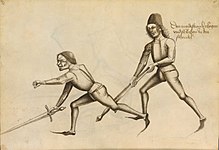Mordhau

The mordhau , murder coating or killing blow called, is in the German fencing school during armored fighting in Short sword (combat fencing), a term for a technique in which the sword upside and two hands of the blade is guided around with the knob or the guard to hit the opponent like with a mace . The sword is usually led (by right-handers ) with the left hand to the tip of the sword and the right hand to the crossguard. The opposite hand position was rare.
The Mordhau was mainly used by armored fighters, more rarely by un- or lightly armored swordsmen. Against plate armor from the 14th to 16th centuries, cuts or blows with the sword blade were almost ineffective. Cutting through the steel plates was hopeless, and a sword blade itself was too light to achieve a sufficient effect through its impact alone, as is the case, for example, with weapons such as the much larger murder ax as a specialized armor combat weapon .
For this reason, sword fighting in armor consisted primarily of levering and throwing as well as stabbing into the gaps in the armor. A very powerful blow aimed at sensitive parts of the body such as the head or joints could, however, have an effect and serve as a preparation for further, final techniques. In addition to the lever and throwing techniques, the Mordhau now served to achieve an effect similar to, for example, a war hammer or mace , i.e. In other words, it was struck with the heavier end of the sword or, in particular, with the crossguard , in order to give the cut significantly more force and thus a greater effect.
Numerous presentations and applications of the murder house contains Hans Talhoffers Fechtbuch Codex icon. 394a from 1467.
See also
Remarks
- ↑ See the issue on Wikisource
